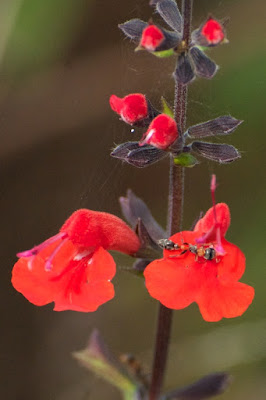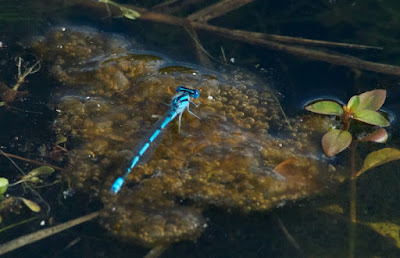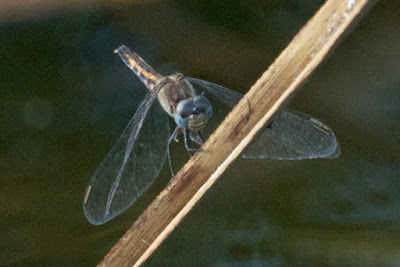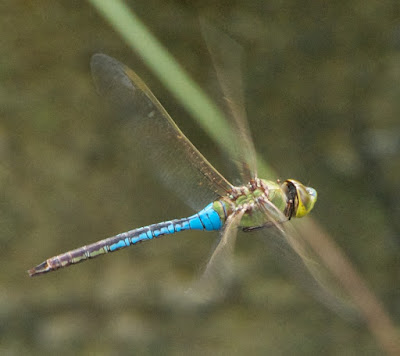Pondhawk centers around a restored marshy area and a scrub zone dotted with pine, underlain with a dense growth of Saw Palmetto (Serenoa repens) and containing some of the largest Pond Apple (Annona glabra) trees in the state.
It is still being restored, and much of it has only recently been replanted with native vegetation.
A paved path through the area provides a good vantage point for watching wildlife...
...and an observation platform over the marsh provides, when the water is high (it isn't always, unfortunately), an excellent platform for photographing dragonflies in flight.
To get to the trail, you cross a bridge over a pond that is still very much a manicured, human creation. There are nearly always a few Muscovy Ducks (Cairina moschata) poking around the edge. These are the descendants of farmyard birds, with lots of white in their plumage, though this one, except for its face, comes closer to the wild birds you might see in tropical America.
I am never quite sure whether the Salvia flowers that bloom along the beginning of the path are garden escapees or genuine wild flowers, though the bright red Tropical Sage (Salvia coccinea) cetrainly grows naturally in South Florida.
The further you go, the more obviously natural the vegetation becomes. American Beautyberry (Callicarpa americana) is a particularly gorgeous example, though it, too, is often planted as an ornamental. Its colourful fruits are popular with a wide range of birds (you can make jelly from them, too).
Pondhawk is not an outstanding bird spot, though I did think that these female Red-winged Blackbirds (Agelaius phoeniceus) made a nice grouping.
It's a lot better for reptiles (though they will have to wait for another time) and insects, including this White Peacock (Anartia jatrophae).
As its name promises, Pondhawk can be very good for dragonflies and damselflies. I found plenty of Atlantic Bluets (Enallagma doubledayi) along the path - Enallagma bluets are the devil to identify, but in South Florida there are far fewer possibilities than at home in Ontario and I can identify these males with some confidence.
The widespread Rambur's Forktail (Ischnura ramburii) is the damselfly I see most often in South Florida. It ranges throughout the southern United States and the West Indies to Venezuela and southern California.
Here is a pair of mating Rambur's Forktails 'in wheel'.
Among the more easily identifiable of the smaller dragonflies is the male Band-winged Dragonlet (Erythrodiplax umbrata), with its long, narrow, cross-barred wings. In eastern North America this is a South Florida specialty, though it is more widespread in the American southwest and ranges south to Argentina. It apparently migrates, sometimes by the millions.
The female is less obvious, and behaves rather differently. Though the males were common enough around the water's edge, I only saw females perched over the path in its more densely-wooded stretches.
I at first took this for the common Blue Dasher (Pachydiplax longipennis), but it was smaller, with duller blue (not green) eyes and no orange on the underside of the thorax. It was, instead, a male Little Blue Dragonlet (Erythrodiplax miniscula). This is a dragonfly that perches low in the pondside vegetation, and is easy to overlook.
This is the female; notice the distinctive dark stripe along the top of the abdomen.
The rather mottled pattern along the side of the thorax reveals this as a female Roseate Skimmer (Orthemis ferruginea). Oddly, I did not see any of the reddish-purple males.
One of the more striking dragonflies at Pondhawk was the Carolina Saddlebags (Tramea carolina), one of a group of dragonflies named for the saddlebag-shaped dark patches on the hindwings.
Saddlebags spend a lot of time on the wing, but when perched I found them quite easy to approach.
The Vermilion Saddlebags (Tramea abdominalis) is a widespread Central and South American dragonfly that reaches extreme southern Florida. The lower photo shows that its "saddlebags" are much narrower than those on the Carolina. The Vermilion Saddlebags can be told from two other very similar South Florida species, the Antillean Saddlebags (T. insularis) and the Striped Saddlebags (T. calverti), by its combination of a red face and black spots on the top of s8, its eighth abdominal segment (the Antillean has a brown face, and in the Striped s8 is almost entirely black).
Here are head-on views of the Carolina and Vermilion Saddlebags in flight. Even if you can't see the saddlebag markings, the red face of the Vermilion (lower photo) distinguishes it from the Carolina.
Though both saddlebags were new to me, I was probably most chuffed about my trips to Pondhawk by my encounters with the Common Green Darner (Anax junius). This is a widespread species (it even shows up in my garden at home) but, like most darners, it rarely holds still. Most of my photographs of it have been less than impressive. Not this time.
These were taken from the observation platform over the pond on November 19, 2013. The pond was full of water, and the darners were hovering just below me (my saddlebag flight shots are from the same spot). For once, I could get them in focus, in good light and against a dark background, and reveal what beautiful insects they are.
My delight at getting these shots is the reason I am sharing so many of them with you. I hope you don't mind, but I find these images a lovely way to bring my account of our travels in 2013, at long last (and very late), to an end.


















































No comments:
Post a Comment